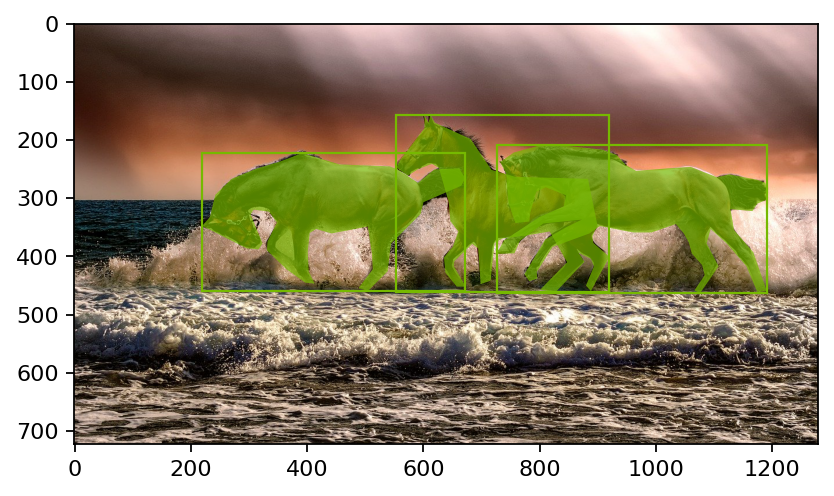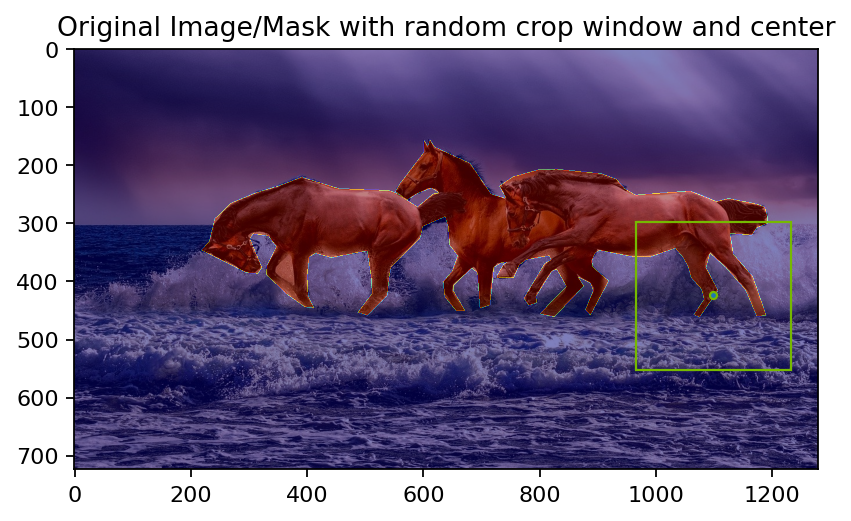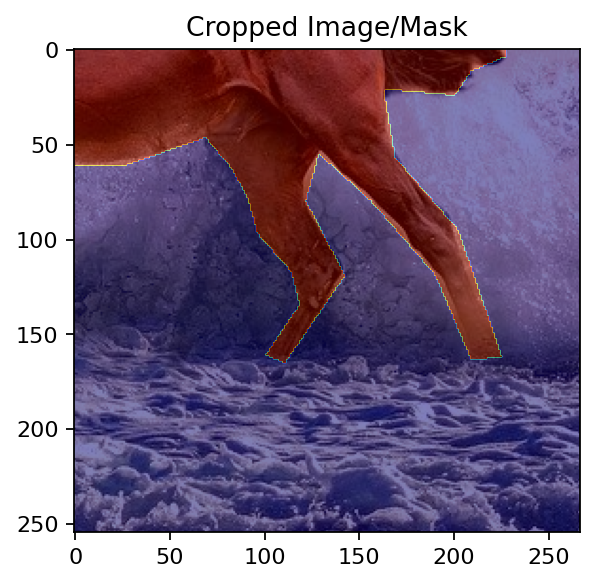COCO Reader with Augmentations#
Here is an example that demonstrates how to combine the COCO Reader, which loads data from a COCO dataset, with some of the typical augmentations used in image detection and segmentation use cases. The COCO dataset consists of a directory with images and an annotations file containing information about bounding boxes, labels and segmentation masks.
[1]:
from nvidia.dali.pipeline import Pipeline
import nvidia.dali.types as types
import nvidia.dali.fn as fn
import nvidia.dali.math as math
import numpy as np
from time import time
import os.path
import random
random.seed(1231231) # Random is used to pick colors
test_data_root = os.environ["DALI_EXTRA_PATH"]
file_root = os.path.join(test_data_root, "db", "coco", "images")
annotations_file = os.path.join(test_data_root, "db", "coco", "instances.json")
num_gpus = 1 # Single GPU for this example
device_id = 0
batch_size = 32
num_threads = 4 # Number of CPU threads
Let us start by defining a simple pipeline that just loads the data
[2]:
pipe = Pipeline(
batch_size=batch_size, num_threads=num_threads, device_id=device_id
)
with pipe:
inputs, bboxes, labels, polygons, vertices = fn.readers.coco(
file_root=file_root,
annotations_file=annotations_file,
polygon_masks=True, # Load segmentation mask data as polygons
# Bounding boxes to be expressed as left, top, right, bottom coordinates
ltrb=True,
)
images = fn.decoders.image(inputs, device="mixed")
pipe.set_outputs(images, bboxes, labels, polygons, vertices)
pipe.build()
We can now run the pipeline and visualize the results
[3]:
import matplotlib.pyplot as plt
import matplotlib.patches as patches
def plot_coco_sample(
image, bboxes, labels, mask_polygons, mask_vertices, relative_coords=False
):
H, W = image.shape[0], image.shape[1]
fig, ax = plt.subplots(dpi=160)
# Displaying the image
ax.imshow(image)
# Bounding boxes
for bbox, label in zip(bboxes, labels):
l, t, r, b = bbox * [W, H, W, H] if relative_coords else bbox
rect = patches.Rectangle(
(l, t),
width=(r - l),
height=(b - t),
linewidth=1,
edgecolor="#76b900",
facecolor="none",
)
ax.add_patch(rect)
# Segmentation masks
for polygon in mask_polygons:
mask_idx, start_vertex, end_vertex = polygon
# Select polygon vertices
polygon_vertices = mask_vertices[start_vertex:end_vertex]
# Scale relative coordinates to the image dimensions, if necessary
polygon_vertices = (
polygon_vertices * [W, H] if relative_coords else polygon_vertices
)
poly = patches.Polygon(
polygon_vertices, closed=True, facecolor="#76b900", alpha=0.7
)
ax.add_patch(poly)
plt.show()
def show(outputs, relative_coords=False):
i = 16 # Picked a sample idx that shows more than one bounding box
images, bboxes, labels, mask_polygons, mask_vertices = outputs
plot_coco_sample(
images.as_cpu().at(i),
bboxes.at(i),
labels.at(i),
mask_polygons.at(i),
mask_vertices.at(i),
relative_coords=relative_coords,
)
outputs = pipe.run()
show(outputs)

A typical augmentation applied in detection and segmentation use cases is a random crop of the image with the restriction that at least one ground truth box is present in the cropped image. In DALI, we use RandomBBoxCrop for that. RandomBBoxCrop operator takes as an input the bounding boxes and the labels associated with them, and a set of constraints for the cropping operation. The result are the cropping window anchor and shape, as well as the processed bounding boxes and labels. The anchor and shape outputs, expressed in relative coordinates, can be directly fed into DALI’s Slice operator to extract the region of interest of the image. The output bounding boxes and labels are processed to contain only the ones within the cropping window, and the coordinates are mapped to the new coordinate space. RandomBBoxCrop does not process segmentation masks, so the mask coordinates need to be mapped to the new coordinate space separately.
[4]:
# Wrapping the pipeline definition in separate functions that we can reuse later
def coco_reader_def():
inputs, bboxes, labels, polygons, vertices = fn.readers.coco(
file_root=file_root,
annotations_file=annotations_file,
polygon_masks=True, # Load segmentation mask data as polygons
# Bounding box and mask polygons to be expressed in relative coordinates
ratio=True,
# Bounding boxes to be expressed as left, top, right, bottom coordinates
ltrb=True,
)
return inputs, bboxes, labels, polygons, vertices
def random_bbox_crop_def(bboxes, labels, polygons, vertices):
# RandomBBoxCrop works with relative coordinates
# The arguments have been selected to produce a significantly visible crop
# To learn about all the available options, see the documentation
anchor_rel, shape_rel, bboxes, labels, bbox_indices = fn.random_bbox_crop(
bboxes,
labels,
aspect_ratio=[0.5, 2], # Range of aspect ratios
# No minimum intersection-over-union, for demo purposes
thresholds=[0.0],
allow_no_crop=False, # No-crop is disallowed, for demo purposes
# Scale range of the crop with respect to the image shape
scaling=[0.3, 0.6],
seed=12345, # Fixed random seed for deterministic results
bbox_layout="xyXY", # left, top, right, back
output_bbox_indices=True, # Output indices of the filtered bounding boxes
)
# Select mask polygons of those bounding boxes that remained in the image
polygons, vertices = fn.segmentation.select_masks(
bbox_indices, polygons, vertices
)
return anchor_rel, shape_rel, bboxes, labels, polygons, vertices
pipe = Pipeline(
batch_size=batch_size,
num_threads=num_threads,
exec_dynamic=True,
device_id=device_id,
)
with pipe:
inputs, bboxes, labels, polygons, vertices = coco_reader_def()
anchor_rel, shape_rel, bboxes, labels, polygons, vertices = (
random_bbox_crop_def(bboxes, labels, polygons, vertices)
)
# Partial decoding of the image
images = fn.decoders.image_slice(
inputs,
anchor_rel,
shape_rel,
normalized_anchor=True,
normalized_shape=True,
device="mixed",
)
# Cropped image dimensions
crop_shape = images.shape(dtype=types.FLOAT) # HWC
crop_h = crop_shape[0]
crop_w = crop_shape[1]
# Adjust masks coordinates to the coordinate space of the cropped image,
# while also converting relative to absolute coordinates by mapping
# the top-left corner (anchor_rel_x, anchor_rel_y), to (0, 0)
# and the bottom-right corner (anchor_rel_x+shape_rel_x,
# anchor_rel_y+shape_rel_y) to (crop_w, crop_h)
MT_vertices = fn.transforms.crop(
from_start=anchor_rel,
from_end=(anchor_rel + shape_rel),
to_start=(0.0, 0.0),
to_end=fn.stack(crop_w, crop_h),
)
vertices = fn.coord_transform(vertices, MT=MT_vertices)
# Convert bounding boxes to absolute coordinates
MT_bboxes = fn.transforms.crop(
to_start=(0.0, 0.0, 0.0, 0.0),
to_end=fn.stack(crop_w, crop_h, crop_w, crop_h),
)
bboxes = fn.coord_transform(bboxes, MT=MT_bboxes)
pipe.set_outputs(images, bboxes, labels, polygons, vertices)
pipe.build()
outputs = pipe.run()
show(outputs)

In the following pipeline, we paste the image to a larger canvas and flip it horizontally
[5]:
pipe = Pipeline(
batch_size=batch_size,
num_threads=num_threads,
device_id=device_id,
exec_dynamic=True,
seed=43210,
)
with pipe:
inputs, bboxes, labels, polygons, vertices = coco_reader_def()
images = fn.decoders.image(inputs)
orig_shape = images.shape()
images = images.gpu()
px = fn.random.uniform(range=(0, 1))
py = fn.random.uniform(range=(0, 1))
ratio = fn.random.uniform(range=(1, 2))
images = fn.paste(
images, paste_x=px, paste_y=py, ratio=ratio, fill_value=(32, 64, 128)
)
bboxes = fn.bbox_paste(
bboxes, paste_x=px, paste_y=py, ratio=ratio, ltrb=True
)
scale = 1.0 / ratio
margin = ratio - 1.0
pxy = fn.stack(px, py)
pxy = scale * pxy * margin
vertices = scale * vertices + pxy
# 100% probability for demo purposes
should_flip = fn.random.coin_flip(probability=1.0)
images = fn.flip(images, horizontal=should_flip)
bboxes = fn.bb_flip(bboxes, horizontal=should_flip, ltrb=True)
vertices = fn.coord_flip(vertices, flip_x=should_flip)
pipe.set_outputs(images, bboxes, labels, polygons, vertices)
pipe.build()
outputs = pipe.run()
show(outputs, relative_coords=True)

In some segmentation and detection datasets, the density of objects is very low. This can cause the background to be overrepresented during training when randomly cropping the image. To compensate for that, we can select crop windows to be centered at foreground pixels with a certain probability.
[6]:
pipe = Pipeline(
batch_size=batch_size,
num_threads=num_threads,
device_id=device_id,
seed=12345,
)
with pipe:
# COCO reader, with piwelwise masks
inputs, bboxes, labels, masks = fn.readers.coco(
file_root=file_root,
annotations_file=annotations_file,
pixelwise_masks=True, # Load segmentation pixelwise mask data
)
images = fn.decoders.image(inputs)
# COCO reader produces three dimensions (H, W, 1). Here we are just removing
# the trailing dimension rel_shape=(1, 1) means keep the first two dimensions
# as they are.
masks = fn.reshape(masks, rel_shape=(1, 1))
# Select random foreground pixels with 70% probability and random pixels
# with 30% probability
# Foreground pixels are by default those with value higher than 0.
center = fn.segmentation.random_mask_pixel(
masks, foreground=fn.random.coin_flip(probability=0.7)
)
# Random crop shape (can also be constant)
crop_w = fn.random.uniform(range=(200, 300), dtype=types.INT64)
crop_h = fn.random.uniform(range=(200, 300), dtype=types.INT64)
crop_shape = fn.stack(crop_h, crop_w)
# Calculating anchor for slice (top-left corner of the cropping window)
crop_anchor = center - crop_shape // 2
# Slicing image and mask.
# Note that we are allowing padding when sampling out of bounds, since
# a foreground pixel can appear near the edge of the image.
out_image = fn.slice(
images,
crop_anchor,
crop_shape,
axis_names="HW",
out_of_bounds_policy="pad",
)
out_mask = fn.slice(
masks,
crop_anchor,
crop_shape,
axis_names="HW",
out_of_bounds_policy="pad",
)
pipe.set_outputs(
images, masks, center, crop_anchor, crop_shape, out_image, out_mask
)
pipe.build()
outputs = pipe.run()
i = 16
image = outputs[0].at(i)
mask = outputs[1].at(i)
center = outputs[2].at(i)
anchor = outputs[3].at(i)
shape = outputs[4].at(i)
out_image = outputs[5].at(i)
out_mask = outputs[6].at(i)
fig, ax = plt.subplots(dpi=160)
ax.imshow(image)
ax.imshow(mask, cmap="jet", alpha=0.5)
rect = patches.Rectangle(
(anchor[1], anchor[0]),
width=shape[1],
height=shape[0],
linewidth=1,
edgecolor="#76b900",
facecolor="none",
)
ax.add_patch(rect)
ax.scatter(center[1], center[0], s=10, edgecolor="#76b900")
plt.title("Original Image/Mask with random crop window and center")
plt.show()
fig, ax = plt.subplots(dpi=160)
ax.imshow(out_image)
ax.imshow(out_mask, cmap="jet", alpha=0.5)
plt.title("Cropped Image/Mask")
plt.show()

